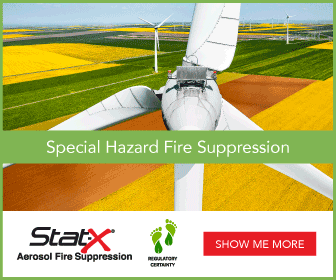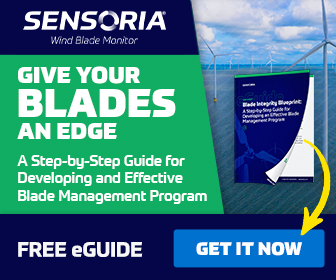Keeping Turbines Safe: Lightning & surge protection
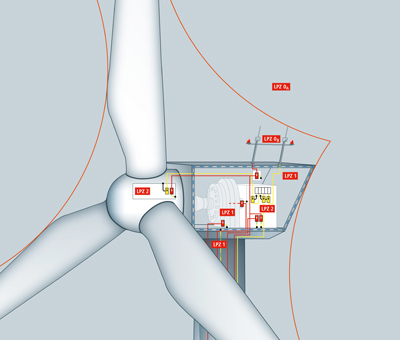 Despite some industry up’s and down’s, wind power remains a leading contributor to the renewable energy portfolio. It not only supplies clean energy, but it’s also a major contributor to the US economy through the support and manufacturing of related products and services. In the United States, more than 64 gigawatts (GW) of wind power are currently installed and producing, which makes the US second in ranking worldwide (exceeded only by China with 75 GW).
Despite some industry up’s and down’s, wind power remains a leading contributor to the renewable energy portfolio. It not only supplies clean energy, but it’s also a major contributor to the US economy through the support and manufacturing of related products and services. In the United States, more than 64 gigawatts (GW) of wind power are currently installed and producing, which makes the US second in ranking worldwide (exceeded only by China with 75 GW).
To maintain, and eventually increase, these power levels, wind energy must continue to serve as a strong and reliable source of energy. Meaning, the research and technology employed—from the base of a turbine to the top of the blades—must be top-notch and efficient. This not only includes overall performance monitoring, but also assessing and monitoring any risks to the turbines.
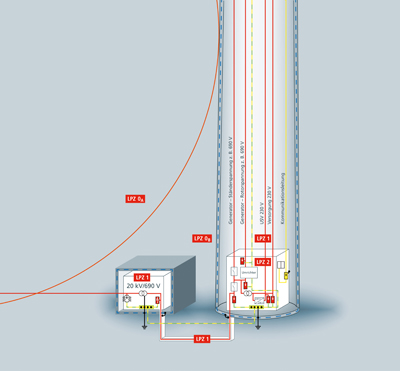 The risk of lightning
The risk of lightning
The required height and placement of wind generators cause them to be highly susceptible to the weather and, particularly, the potential of direct and indirect lightning hits. Multi-megawatt wind turbines, including their blades, are now reaching heights of up to 700 feet, so are especially at high risk of damage. As a result, cloud-to-earth flashes and earth-to-cloud flashes (so called upward flashes) must be factored into any major wind farm design. In fact, according to risk calculations, a direct lightning strike must be expected every 12 months due to the height multi-megawatt turbines are now reaching.
A wind farm is amortized by its energy production and, therefore, any turbine downtime is an expense that’s to be avoided at all costs—particularly, when factoring in the additional price of any repairs or replacements. It’s essential that lightning-related events are mitigated by the installation of a comprehensive system for lightning and surge protection.
Long-term tacking shows that most direct lightning strikes impact the blades. Beside the mechanical damage at the blade-level, however, there’s usually damage inside the turbines as well.
Mostly applied components include the following:
- Frequency converter;
- Turbine controller;
- Speed sensor; and
- Wind sensors.
Protecting turbines
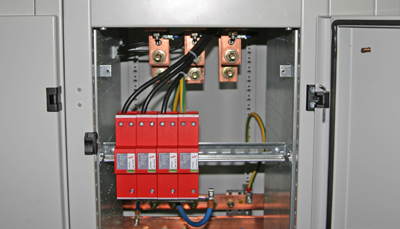 To ensure the safety of wind turbines, testing and certification are done according the international guideline of Germanischer Lloyd. This includes the demand for a lightning protection system, according to IEC 61400-24. This guideline further recommends a design based on the lightning protection level (LPL) 1 for wind turbines.
To ensure the safety of wind turbines, testing and certification are done according the international guideline of Germanischer Lloyd. This includes the demand for a lightning protection system, according to IEC 61400-24. This guideline further recommends a design based on the lightning protection level (LPL) 1 for wind turbines.
The basis for the inner lighting protection system is formed by the lightning protection zone concept (see Image 1). Here’s a breakdown of the external and internal systems…
-
External lightning protection
The external lightning protection system consists of an air-termination system, down-conductor, and an earthing (grounding) system. It serves to protect a wind generator from mechanical damage and fire. Because the bladed are at greatest risk of receiving a direct strike, the rotor blades are protected by use of integral lightning receptors, along with down-conductors and brush mechanisms to electrically bond the rotating assembly to the stationary one.
The nacelle and any components on top, such as anemometers and aviation lights, are protected by air-terminals that are connected to the grounding system. Finally, a down-conductor within the tubular steel tower can be used or, for concrete towers, an integrated grounding system can be designed.
-
Internal lightning protection
The internal lightning protection system mitigates the effects of conducted and induced transients. This is accomplished through the concept of equipotential bonding, which reduces any potential differences that are generated by a lightning current (due, in part, to any ground potential rises).
In addition to the equipotential bonding, all cables and conductors should be connected via lightning current-arresters to the equipotential bonding system. Type 1 surge protection devices (SPDs), for instance, are able to discharge lightning currents without being damaged (see Image 2; also note sidebar for the “Special requirements of SPDs”). Furthermore, communications and signal-interfaces for the transfer of operating data and between the components of a turbine must also be integrated to the lightning equipotential bonding system. Combined arresters are most suitable for this, as they offer equipotential bonding and over-voltage protection for the sensitive signal interfaces.
Lastly, by employing a condition monitoring system for the SPDs, turbine downtime can often be avoided. A good monitoring system allows for a fast and easy inspection, without demounting of the module (see Image 3).
Special requirements for SPDs
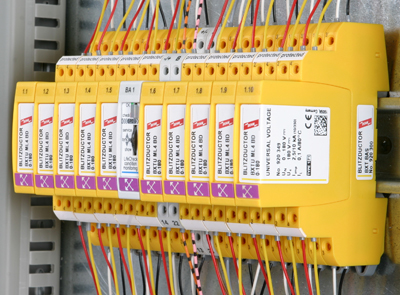 Surge Protection Devices (SPDs) are important components of the electrical installation protection system of any wind turbine, and particularly utility-sized turbines as their height puts them at significant risk to lightning hits.
Surge Protection Devices (SPDs) are important components of the electrical installation protection system of any wind turbine, and particularly utility-sized turbines as their height puts them at significant risk to lightning hits.
Ideally, SPDs should…
- Withstand special ambient conditions, (i.e. ambient temperature, mechanically vibrations, etc.);
- Provide high discharge capabilities, especially in high-risk lightning areas;
- Offer capability for condition monitoring; and
- Supply proof of the protection level via an immunity test at system level (i.e. IEC 61400-24).
Electro-magnetic field measures
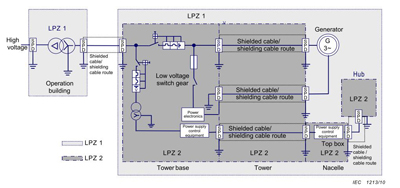 The lightning protection zone concept, according to IEC 62305, is the design guideline for the electro-magnetic field (EMF) protection in wind energy turbines (see: 61400-24; appendix E). Herein, the generator system is categorized into different protection zones, which are defined by different electromagnetic environmental conditions. Distinctions are also made between induced and direct lightning influences, so that protection is applied accordingly (see Image 4). By shielding, induced electromagnetic disturbances can be substantially reduced.
The lightning protection zone concept, according to IEC 62305, is the design guideline for the electro-magnetic field (EMF) protection in wind energy turbines (see: 61400-24; appendix E). Herein, the generator system is categorized into different protection zones, which are defined by different electromagnetic environmental conditions. Distinctions are also made between induced and direct lightning influences, so that protection is applied accordingly (see Image 4). By shielding, induced electromagnetic disturbances can be substantially reduced.
Because of the architecture of wind turbines, shielding measures can be implemented more easily if considered at the time of initial design. For instance, the nacelle can be engineered as an enclosed metallic shield. Electrical components, such as the turbine controller and other electronics components, can and should be integrated into metallic cabinets and housings with high-damping factors. Connection cables between these cabinets can also be created with shields that are capable of safely carrying lightning currents. The shield should be contacted to 360 degrees as a best-case scenario.
Conclusion
Lightning and surge protection are a significant requirement for the safe and failure-free operation of wind turbines, safeguarding against unnecessary turbine damage and downtime. Ideally, protection systems should be considered, designed, and implemented during the earliest stages planning phases to avoid any challenges post-production. The fewer service and repair costs needed once turbines are in place, generally means greater wind energy harvesting—an important goal if the industry is to offer continued growth and success.
Bernhard Eichler, Dipl-Ing (FH), is an electrical engineer and is the senior market manager of Wind Energy at DEHN + SÖHNE.
Robert Schlesinger, PE, is an electrical engineer with 30 years of experience in the utility and power industry, including more than 10 years with DEHN. He is a senior member of the IEEE, and has served on multiple working groups within the PES.
DEHN, Inc.
www.dehn-usa.com
Author: Bernhard Eichler, Dipl.-Ing (FH) & Robert Schlesinger, PE; with Michelle Froese
Volume: July/August 2014










.jpg?r=2374)
